|
PRESENTATION GRADE CIVIL WAR SABER
|
||||

OBVERSE VIEW OF A H. SAUERBIER PRESENTATION GRADE SABER IN SCABBARD
|
||||
|
|
||||
|
|
||||
|
On August 15, 1861, H. Sauerbier received a contract from the government
for 100 Infantry officer's swords. It is believed that these swords
all have iron scabbards with tooth-leaf designed brass scabbard
mounts and a small petite "U.S." cast into the brass guard. Most
do not bear the maker's name.
|
||||
|
Henry Sauerbier was a cutler/ edged tool maker who in 1848 took
over a business started by John H. Crawford in Newark, New Jersey.
In 1851, Aaron Crawford had this firm in his own name and
formed Crawford, Brown & Sauerbier. This firm was dissolved
in 1853 and in 1855 Henry Sauerbier & Company started manufacturing
saddle, harness and shoemakers tools. His early tools were marked:
H. SAUERBIER. Around 1870 tools became marked: H. SAUERBIER
& SONS. Henry died in 1874 and from 1875 to 1887 the business
name was H. SAUERBIER'S SONS.
|
||||
|
During the war, he also made a variation of the M1840 cavalry swords
as well as non-regulation cavalry enlisted and officer's swords
plus M1850 foot officer swords, and M1860 staff and field officer's
swords. He is noted for making very unusual presentation swords
with picture, soldier-head and precious stone pommels. He utilized
silver and pewter hilts and as well as silver and pewter decorations
on the hilts and scabbards on these swords. He also sold swords
to several other retailers, including Schuyler, Hartley & Graham,
in addition to selling blades to many silversmiths.
|
||||
|
A great example of one of his presentation grade swords is photo
detailed in this posting.
|
||||

REVERSE VIEW OF SABER OUT OF SCABBARD
|
||||
|
Due to the make up of this sword, it is heavier than most. It weighs
4-1/2 pounds in the scabbard with the sword itself being 2-3/4 pounds
and the scabbard, 1-3/4 pounds. The overall length of the sword
is 39-1/2" with the blade being 34-1/4" long and 1-5/16" wide by
3/8" thick at the hilt.
|
||||
|
|
||||
|
|
||||
|
The upper incised brass ring holder band is 4-5/8" long on the obverse.
It is heavily incised with a sweeping leaf design punctuated with
small acorns and oval panels with rope like borders above and below
the carrying ring. The upper inlayed oval panel is a pewter 5 pointed
star. The lower oval panel appears to be a pewter cannon barrel
in the firing stage overlaid by a leafy design. The ring holding
band is 5-1/2" on center from the scabbard throat.
|
||||

OBVERSE VIEW OF UPPER BAND / CARRYING RING
|
||||
|
The middle or lower incised ring holder band is 4-1/2" long on the
obverse. It is positioned 7-3/4" on center from the the upper ring
holding band. The incised design is similar to that of the upper
band but with the upper inlayed oval rope framed panel containing
a silvered "U.S" within a pewter wreath and the lower panel having
a pewter cannon barrel overlaid with a scroll. There are two lines
of lettering on the scroll. The top line is illegible. The bottom
line is "UNION".
|
||||
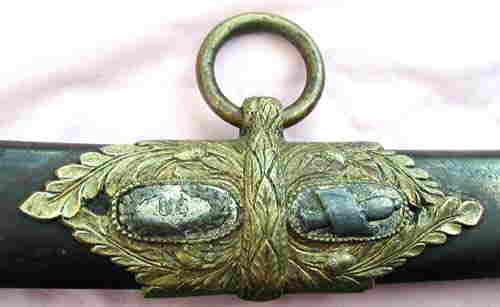
OBVERSE VIEW OF MIDDLE LOWER BAND / CARRYING RING
|
||||
|
The brass drag is 4-1/2" long. It too is heavily incised with
the leaf and acorn design. A single rope framed oval panel contains
a floral or leaf design.
|
||||

OBVERSE VIEW OF DRAG
|
||||
|
The blued steel scabbard is engraved with a 9-1/4" long floral,
leaf and ribbon design between the lower carrying ring band and
the drag. Within the ribbon, in block lettering is "E PLURIBUS
UNUM".
|
||||

SCABBARD ENGRAVING - OBVERSE
|
||||
|
Reverse view of the the throat, carrying ring bands and drag. Note
the modified heart cutouts on the carrying rings and the elongated
shield cutout on the drag.
|
||||

|

|
|||
|
|
||||
|
|
||||
|
|
||||
|
The hilt has a pewter grip wound with 1 twisted strand of wire centered
between two plain strands.
|
||||

OBVERSE VIEW OF HILT
|
||||
|
The half-basket sweeping incised brass guard protects the hand in
it's entirety. On the bottom of the guard is a single engraved flower
with 5 petals. A larger more heavily incised flower with leaves
is located on the top of the quillon and on the face of the hilt.
|
||||
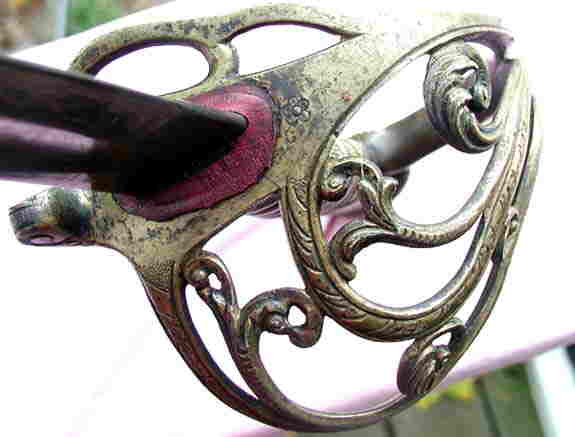
|
||||

|
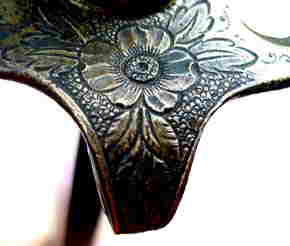
|
|||
|
|
||||
|
There is a very stylized entwined U.S. on the top of the pommel
within a rope type bordered oval. On the face of the upper hilt
is a pewter shield with ribbon within another rope bordered oval.
On the ribbon is the word "UNION".
|
||||

VIEW OF POMMEL TOP
|
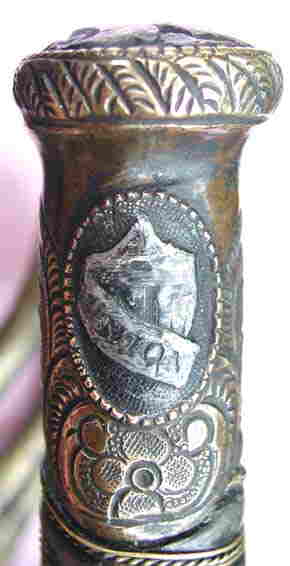
FACE OF UPPER HILT
|
|||
|
|
||||
|
|
||||
|
The curved blade has a 30" long wide fuller extending from 3/8"
above the guard to 3-1/2" from the point. Their is also a median
ridge or second narrow fuller along the top of the blade starting
11-1/2" from the hilt and extending 14" to within 8-3/4" of the
point. The modest false edge is 5-1/2" in length. The largely frosted
blade is profusely etched on the obverse with a lower panel of flags
and a stand of arms, a middle panel of an eagle, shield, American
flag, cannon and implements including spears and pikes, with floral
and leaf etching between and above the panels. The reverse has the
maker's name and city at the bottom; "H. Saurbier/NEWARK/N.J.",
panels of a cannon firing scene with artillery men reminiscent of
an earlier time and a stylized "U.S." with floral and leaf etchings
between and above. In the lower floral and leaf panel, what appears
to be a perched eagle is in evidence. The back of the blade has
25 small etched frosted panels with 13 of them containing a design
of 4 dots in each and 12 having a single dot. The panels and dots
step down in size as they progress from the higher to the lower
back of the saber blade.
|
||||
|
||||

Floral, Leaf & Scroll Engraving
|
||||
|
|
||||
|
|
||||
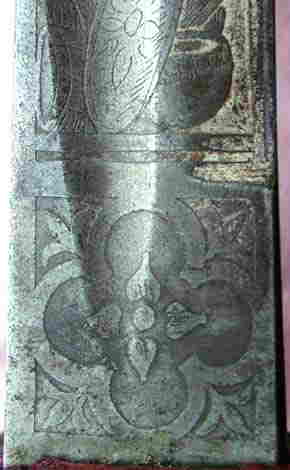
|
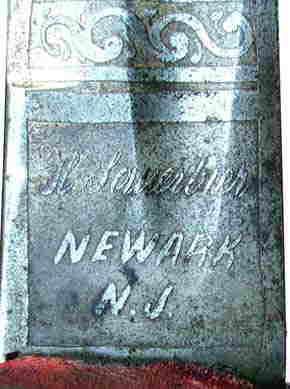
|
|||
|
"H. Sauerbier / NEWARK / N. J."
|
||||
|
|
||||
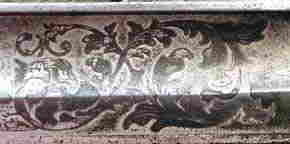
Note Perching Eagle - Above Right
|
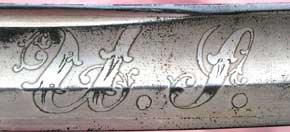
Stylized "U. S."
|
|||

Artillery Engraving
|
||||

Floral & Leaf Engraving
|
||||
|
Top Of Blade Etching
|
||||
|
|
||||
|
|
||||
|
|
||||
|
Following is a list of patents awarded to Henry Sauerbier:
|
||||
| U.S.
Patent No. 00024494, Dated June 21, 1859, "Tool for Planing and
Finishing the Edges of Boot and Shoe Soles", Henry Sauerbier, of
Newark, New Jersey.
|
||||
| U.S.
Patent No. 00067313, Dated July 30, 1867, "Improved Shave for Boots
and Shoes", Albert E. Johnson, of Oxford, Massachusetts.
|
||||
| U.S.
Patent No. 00069490, Dated October 1, 1867, "Improved Shoe Knife",
Henry Sauerbier, of Newark, New Jersey.
|
||||
| U.S.
Patent No. 00221866, Dated November 18, 1879, "Improvement in Leather-Splitting
Machines", Henry Sauerbier and Julius Sauerbier, of Newark, New
Jersey.
|
||||
| U.S.
Patent No. 00221867, Dated November 18, 1879, "Improvement in Leather-Splitting
Machines", Henry Sauerbier and Julius Sauerbier, of Newark, New
Jersey.
|
||||
| U.S.
Patent No. 00221868, Dated November 18, 1879, "Improvement in Rein-Rounding
Machines", Henry Sauerbier and Julius Sauerbier, of Newark, New
Jersey.
|
||||
|
|
||||
|
Reference information for this posting came from "The American
Sword 1775 - 1945" by Harold L. Peterson, "American Swords
And Sword Makers" by Richard H. Bezdek, "Dictionary Of American
Military Goods Dealers And Makers 1785 - 1915" by Bruce S. Bazelon
and William F. McGuinn, and miscellaneous information found on the
World Wide Web.
|
||||
|
All photographs are originals of mine. Any assumptions or errors
in this posting are my responsibility also. The webmaster is my
son, Reed Radcliffe. He somehow transforms the data I send
to him into a presentable package for your viewing pleasure. We
both sincerely hope that you enjoyed your visit with us.
|
||||
| Dave Radcliffe | ||||


